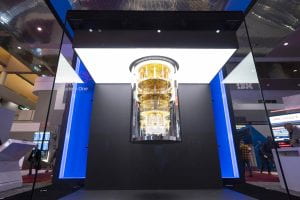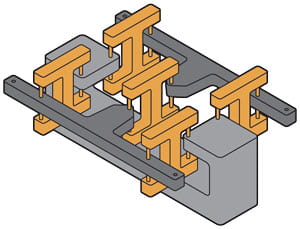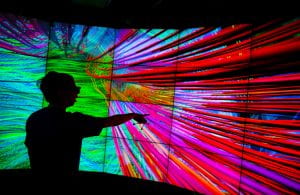There are many areas which hold promise to power the next computing revolution. At the Center for Research into Novel Computing Hierarchies, we investigate a wide variety of these areas, as it’s likely that all of them will yield benefits in the years ahead.
Quantum Information Sciences

Information can be encoded into selected states of quantum systems. A quantum system is any particle or small structure whose behavior is governed by quantum mechanics. Examples of such systems are electron orbitals in ions or atoms, polarization in photons, and electrical current loops in superconductors. When a number of these quantum bits (or qubits) are collected together into specially prepared “entangled” states, they can be used to execute certain algorithms far more efficiently than a classical computer could. These algorithms include factoring large numbers, searching unsorted databases, and simulating quantum phenomena in larger systems than currently feasible. Quantum phenomena simulation, in particular, will aid research in protein folding, phase transitions in material systems, and chemical dynamics.
Brain-Inspired Computing

Brain-inspired computing takes what we know about how the brain operates and applies it to new computing technologies. This allows us to solve problems at which the brain is highly skilled, such as efficiently recognizing and classifying patterns in text, audio and images. Investigations into brain-inspired computing strive to design computers that can operate at low power, have high tolerance for faults, and can learn from input data—much like a brain.
Adiabatic and Reversible Computing

Adiabatic and reversible computing aim to reduce the power needs of devices by recycling unused outputs in a circuit. Like cryogenic superconductors, adiabatic and reversible computers can be compatible with our existing software base. However, to be most efficient, they must be implemented with vastly different kinds of electronic devices than are available today.
Approximate Computing

Today’s computers often calculate results to a degree of precision and accuracy that is much higher than required. Approximate computing strives to remove this wasted processing to both increase computing speed and reduce power requirements. In addition, certain kinds of electronic devices can be made to run very fast and be highly energy efficient, but in so doing they produce random errors. Creating computers that use these methods requires developing new algorithms, new computer languages, and new computer architectures. CRNCH faculty work to create these aspects and make these approaches successful.
Design Sciences

Harnessing new devices and technologies requires new design methodologies. Changes to devices and interconnect will ripple through the design stack, affecting architectures and software. Mapping the design space helps designers make the most effective choices for hardware and software design. CRNCH faculty are inventing new algorithms and models to create revolutionary new computing systems from revolutionary new technologies.